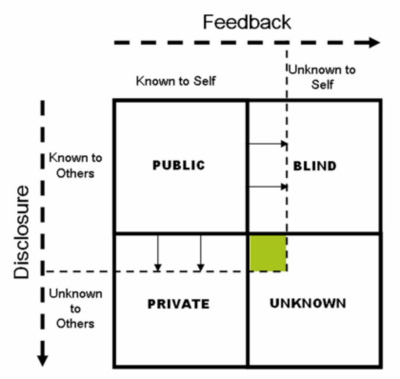Windows 2 C U & Me

When I first learned about the Johari Window, way back in graduate school, I thought it had to be some kind of eastern mystical concept related to Hinduism or Buddhism. I remember feeling a bit relieved when I learned that it was actually a simple tool developed by a couple of American psychologists for improving interpersonal dynamics.
The name, Johari, is actually a combination of their first names: Joe and Harry.
The Johari Window is just a common sense way to explain how you see yourself and others. Imagine that you look out through this window at others and they see you through this same window.

Reading it like a graph, you’ll see that the vertical side of this window represents information about you that is known to others. “Others” may be your family, or your coworkers, or people at church, etc. The horizontal side of the window represents information that you know about yourself. So the Johari Window represents how you as an individual relate to a particular group.
Each of us would have different size window “panes” depending upon the group we are looking at. For example, if you have been attending a small group Bible study for many years, then that group will know you really well, in contrast with people you recently met at the gym.
The first quadrant of the window represents all the information that is known by others about you, as well as the information that you know about yourself. If you are an open book, rarely keep secrets from other people, and you know yourself well, then this area of the window would be large compared to the other three quadrants (as shown on the graphic by the dotted lines).
This first pane of the window is referred to as the “Public Area.” Healthy people tend to be part of a group where you can be yourself, share personal information, and receive support and guidance. We should strive to have multiple support systems in place where intimacy and trust is fostered.
One of the best ways to grow in understanding of ourselves is to let others give us feedback in areas where we are blind. This is indicated in the second quadrant of the Johari Window, known as the “Blind Area.” We all have our blind spots, aspects of our personality or habitual behaviors that we do not see clearly, but others do.
You can probably think of someone in one of your social groups who comes across as a “know-it-all” or possibly someone who talks way too much, but they are unaware of how their behavior is coming across to others. They are oblivious to the impact of their poor social skills.
The third pane of the window is the “Private” portion of our lives. Clearly, we all have information that we keep to ourselves. However, intimacy and closeness to others requires taking the risk of sharing some of our struggles. As a person self-discloses and moves Private information to the Public area, the hidden part of the window decreases. Generally, this process is a sign of self-confidence and positive mental health. As Rick Warren is quoted as saying, “You are only as sick as your secrets.”
The final pane of the Johari Window represents “Unknown” information about ourselves that no one knows, including ourselves. This might be unconscious motivations, defense mechanisms or repressed memories. Generally speaking, the more baggage we carry around within us, the more we tend to feel anxious, depressed and out of control.
This is where godly counsel may help each of us considerably. Finding a safe place to share your private struggles and receive gentle feedback is often a painful but growing experience. It can be laborious process to clean the windows of our lives, but if it leads to greater self-understanding and improved interpersonal relationships then the effort is worth the time.
— by Daniel Jenkins, Ph.D.
Jenkins is a licensed clinical psychologist at Lighthouse Psychological Services in Mission Valley. He is also a professor at Point Loma Nazarene University. Learn more at www.lighthousepsy.com.





